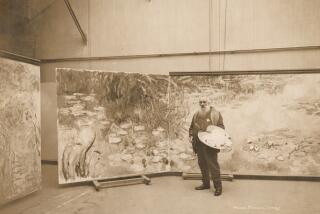DISCOVERIES
- Share via
Rembrandt’s Nose
Of Flesh & Spirit in the Master’s Portraits
Michael Taylor
Distributed Art Publishers: 168 pp., $27.50
READING about paintings is delightful, perhaps because the annoyance one often feels at being lectured on a painter’s technique or intentions is dealt with simply by turning the page. Taylor has a light touch; he’s not the first to discuss the small in Rembrandt’s rich work (he’s particularly inspired by Simon Schama’s “Rembrandt’s Eyes”), but he does claim to be the first to focus on the Master’s fascination with noses (his own and others). “Rembrandt lavished as much care on layering pigment to build up a nose as on capturing the play of reflections and shadows in an eye. He rendered the complexion of a nose with the same fastidiousness he brought to paraphrasing the sheen of velvet or fur.”
Rembrandt produced more than 80 self-portraits. He often used his own features in other paintings and in his etchings. Many of his subjects were financial wizards, movers and shakers in the powerful Dutch aristocracy of the 1600s. “[I]t is hardly surprising,” Taylor writes, “that the features Rembrandt emphasized in his portraits of them were the ones commonly associated with those gifts: the eyes, the nose, and jaw.”
Reading Taylor, one is convinced that the painter conveyed much of his wisdom regarding human nature with his subjects’ noses. The book is full of reproductions. Alone, in total privacy, you can agree or disagree with Taylor’s ideas; look, look again, look again!
---
You Won’t Remember This
Stories
Kate Blackwell
Southern Methodist University Press: 248 pp., $22.50
HOW do writers do it? How do they take the same tiresome human dramas and make us care, make us wonder how it will turn out this time? In the first story in this debut collection, “My First Wedding,” the narrator asks, “For who will remember women like my mother, my aunt, and Augusta? Who will remember any of us who live so hidden, so far from nearly everything?” The details of their lives, like those of many of Kate Blackwell’s middle-class women, are familiar to the point of invisibility. But something inside them struggles to get out.
Books are the fount of all the passions and opinions of the matriarchs in “My First Wedding.” They discuss and dismiss authors with absolute confidence, even as much of their own lives is beyond their control. In “The Secret Life of Peonies,” Alexandra, so preppy, so ordinary you might not even notice her in real life, exposes a rage to the reader that threatens to rip the social fabric she and her husband hide behind. In “What We Do for Love,” hypocrisy and fascination with the downfall of others (in this case, the courtroom drama of a “local blueblood” who shoots his wife and her lover) provide the needed distraction. Blackwell’s onto something about the way we fold love into life that may prove useful: Best be on the safe side.
--
Chewing Gum in Holy Water
A Childhood in the Heart of Italy
Mario Valentini and Cheryl Hardacre
Arcade: 322 pp., $26
THIS lively memoir, told by Mario Valentini to his partner, Cheryl Hardacre, is full of rich details from Valentini’s postwar Italian childhood. When he is 4, Valentini, whose father works in Germany and whose mother cannot support three children, leaves his birthplace, the hilltop village of Collemare in the mountains of the Abruzzo, to live with his uncle, a traveling priest. He grows up hunting wolves in the woods with a slingshot, playing in castle ruins and eating the wild country foods of Italy: pancetta, polenta and confetti (almond sweets) made by nuns. He is constantly getting into trouble. He makes a fioretto, a promise of a small sacrifice to his uncle not to chew gum in church. The feeling of the air, the smell of dust, the taste of chewing gum -- Valentini’s vivid memories are the result of a life fully lived with all five senses and a true sense of humor.
More to Read
The biggest entertainment stories
Get our big stories about Hollywood, film, television, music, arts, culture and more right in your inbox as soon as they publish.
You may occasionally receive promotional content from the Los Angeles Times.










